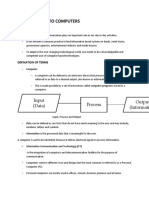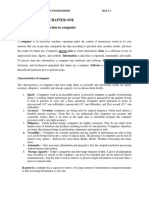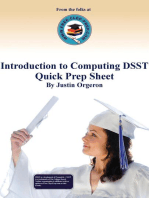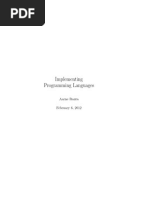0 ratings0% found this document useful (0 votes)
75 viewsIntroduction To Computer: Prepared by Shahzeb Khan
Computers can be classified in several ways:
1. By size - ranging from microcomputers (desktops, laptops) to minicomputers, mainframes, and supercomputers.
2. By data handling - analog computers handle continuous signals while digital computers store data discretely in binary format. Hybrid computers exhibit features of both.
3. By purpose - general purpose computers can perform many tasks through software while special purpose computers are dedicated to a single task for optimized performance.
Uploaded by
Zeebo KhanCopyright
© © All Rights Reserved
We take content rights seriously. If you suspect this is your content, claim it here.
Available Formats
Download as PDF, TXT or read online on Scribd
0 ratings0% found this document useful (0 votes)
75 viewsIntroduction To Computer: Prepared by Shahzeb Khan
Computers can be classified in several ways:
1. By size - ranging from microcomputers (desktops, laptops) to minicomputers, mainframes, and supercomputers.
2. By data handling - analog computers handle continuous signals while digital computers store data discretely in binary format. Hybrid computers exhibit features of both.
3. By purpose - general purpose computers can perform many tasks through software while special purpose computers are dedicated to a single task for optimized performance.
Uploaded by
Zeebo KhanCopyright
© © All Rights Reserved
We take content rights seriously. If you suspect this is your content, claim it here.
Available Formats
Download as PDF, TXT or read online on Scribd
You are on page 1/ 20
Introduction to Computer
Prepared by Shahzeb Khan
Computer
• The word “Computer” came from the word “Compute” which means
“to calculate”.
• A computer is an electronic machine that
• accepts data as input,
• processes that data using programs,
• outputs the processed data.
• can store data for future processing.
• Or simply we can say that a computer is an electronic device which
can perform arithmetic operations at very high speed.
Major Components of a Computer
• Computer components are divided into two major categories namely:
• Hardware
• Software.
• Hardware is the machine itself and its connected devices such as
monitor, keyboard, mouse etc.
• Software are the set of programs that make use of hardware for
performing various functions such as operating systems, applications,
drivers etc.
Characteristics of a Computer
• The characteristics of computers that have made them so powerful and
universally useful are:
• Speed: Computers work at an incredible speed and a powerful computer can
perform about 3-4 million simple instructions per second.
• Accuracy: In addition to being fast, computers are also accurate (processing
without any mistakes).
• Diligence: Unlike human beings, computers are highly consistent. They do
not suffer from human traits of boredom and tiredness resulting in lack of
concentration.
• Versatility: Computers are versatile machines and are capable of performing
any task as long as it can be broken down into a series of logical steps. The
presence of computers can be seen in almost every sphere:
• Railway/Air reservation, Banks, Hotels, Weather forecasting and many more.
• Storage Capacity: Computers can store large volumes of data. It can never
forget the recorded data and can be retrieved almost instantaneously.
Basic Functions of a Computer
• While the functions and applications of a computer are almost
endless, the basic operations or functions of a computer are:
• It accepts data or instructions as input (Inputting)
• It stores data and instruction (Storing)
• It processes data as per the instructions (Processing)
• It controls all operations inside a computer (Controlling)
• It gives results in the form of output (Outputting)
Basic Functions of a Computer
Basic Computer Organization
• A computer system consists of mainly four basic units, namely:
• Input Unit
• Storage Unit
• Central Processing Unit (ALU And Control Unit)
• Output Unit
Basic Computer Organization
• Input Unit: This unit is used for entering data and programs into the computer system
by the user for processing through Input devices.
• Storage Unit: The storage unit is used for storing data and instructions before and
after processing.
• Output Unit: The output unit is used for providing the result to the outside world as
output is produced by the computer after processing.
• Processing: The task of performing operations like arithmetic and logical operations is
called processing. The Central Processing Unit (CPU) takes data and instructions from
the storage unit and makes all sorts of calculations. CPU includes Arithmetic Logic
Unit (ALU) and control unit.
• Arithmetic Logic Unit: All calculations and comparisons, based on the instructions provided, are
carried out within the ALU. It performs arithmetic functions like addition, subtraction,
multiplication, division and also logical operations like greater than, less than and equal to etc.
• Control Unit: Controlling of all operations like input, processing and output are performed by
control unit. It takes care of step by step processing of all operations inside the computer.
Classification of Computers
• Computers can be classified in many ways. Some common
classifications of computers are summarized below:
• On the basis of Size
• On the basis of Data Handling
• On the basis of Purpose
• On the basis Brand
On the basis of Size
• Microcomputers:
• Like their name suggests, microcomputers contain the functionality of
a larger computer, but in a significantly smaller form.
• Information systems, which once filled an entire room, could now fit in
a small silicon chip.
• Microcomputers are generally considered the smallest, most affordable
and most reliable computers.
• Example are: Desktops, Laptops, Palmtops, etc.
On the basis of Size
• Minicomputers:
• Microcomputers and Minicomputers may sound similar, but they are
very different types of computers.
• Minicomputers were developed in the 1960s as midrange computers,
which boasted relatively high processing speed, but at a significantly
smaller size and price compared to larger mainframe and
supercomputers.
• But don't let the word "small" fool you. Some minicomputers still stood
over 6 feet and weighed upward of 700 pounds.
• Examples: DEC PDP-8 or Straight-8 minicomputer (1965)
On the basis of Size
• Mainframe Computers:
• A mainframe computer is a powerful, multi-user computer that
supports hundreds or even thousands of simultaneous users.
• Today, this is typically used in a commercial environment.
• In fact, servers – including database servers, Web servers, transaction
servers, email servers and more – are all types of mainframes.
On the basis of Size
• Super Computers:
• A supercomputer is a computer that can process enormous amounts of
data, especially relative to other machines of its time (i.e., your iPhone
would've been a supercomputer in the 1950s). Some supercomputers
comprise more than 100 individual computers.
• To give you an idea of the scale, the U.S. government's $200 million
Summit system at Oak Ridge National Laboratory is the world's
fastest supercomputer as of 2018.
• Summit's 36,000 processors can perform 200 quadrillion calculations
per second.
• Calculations Summit can achieve in an hour would take the home
computer about 30 years to accomplish.
On the basis of Data Handling
• Analog Computers:
• Due to the limitations of digital computing in the 1960s and 70s,
engineers, technicians and scientists solved complex problems using
analog computers.
• An analog computer generates continuous signals using dials and
switches for input, and meters for output.
• The main feature that distinguishes digital from analog computers is the
nature of the signals. Digital signals have two discrete states, on or off.
• Analog signals are continuous. They may have any value between two
extremes, such as -15 and +15 volts.
• Examples include temperature, pressure, telephone lines, Speedometer,
etc.
On the basis of Data Handling
• Digital Computers:
• A digital system is a system that stores data in a discrete way.
• Digital systems store the information in a binary format; that is, every bit
of information cannot have a value other than zero (off) or one (on).
• Larger amounts of data are stored as a string of these bits, which means
a set of 0s and 1s together make a meaning to the system.
• Examples include IBM PC, the Apple Macintosh as well as modern
smartphones.
On the basis of Data Handling
• Hybrid Computers:
• Hybrid computers are computers that exhibit features of analog
computers and digital computers.
• It takes analog signals, converts it into digital format and processes them.
• The following are examples of hybrid computers used:
• Computer used in hospitals to calculate the heart rate of the patient
• Devices used in petrol pump that converts fuel flow measurements into
quantity and price values
On the basis Purpose
• General Purpose Computers:
• General purpose computers are designed to perform a wide variety of
functions and operations.
• Simply by using a general purpose computer and different software, various
tasks can be accomplished, including
• writing and editing (word processing),
• manipulating facts in a data base,
• tracking manufacturing inventory,
• making scientific calculations, or even controlling organization’s security system.
• This ability is often achieved at the expense of speed and efficiency.
On the basis Purpose
• Special Purpose Computers:
• As the name states, a Special-Purpose Computer is designed to be task
specific and most of the times their job is to solve one particular problem.
• They are also known as dedicated computers, because they are dedicated
to perform a single task over and over again.
• Such a computer system would be useful in playing graphic intensive
Video Games, traffic lights control system, navigational system in an
aircraft, weather forecasting, oil exploration, and in automotive
industries, keeping time in a digital watch, etc.
• As these computers have to perform only one task, therefore, they are fast in
processing
On the basis Brand
• The following are well-known brands for computers:
• IBM (International Business Machines)
• HP (Hewlett-Packard)
• Apple Inc
• Dell
• Asus
• Lenovo
• Acer
• Sony, etc.
Classification of Computers
You might also like
- Facebook Use Case Diagram Activity Diagram Sequence Diagram100% (1)Facebook Use Case Diagram Activity Diagram Sequence Diagram16 pages
- Chapter One Introduction To Computer: of ComputersNo ratings yetChapter One Introduction To Computer: of Computers8 pages
- 160_16SNMECA2-16SNMECS2-16SNMEIT1_2020051804402830No ratings yet160_16SNMECA2-16SNMECS2-16SNMEIT1_202005180440283037 pages
- 1.fundamentals of Computer & Programming PDFNo ratings yet1.fundamentals of Computer & Programming PDF67 pages
- Basic Computer Skills - Docx 20240613 123040 0000No ratings yetBasic Computer Skills - Docx 20240613 123040 000042 pages
- A Report On Introduction To Computer Systems50% (4)A Report On Introduction To Computer Systems6 pages
- Unit 1 Computer Systems and Organisation (CSO)No ratings yetUnit 1 Computer Systems and Organisation (CSO)125 pages
- Computer Fundamental & Office Automation (BCA-102)No ratings yetComputer Fundamental & Office Automation (BCA-102)209 pages
- Nursing Informatics Week 1-3 (Computer Hardware)No ratings yetNursing Informatics Week 1-3 (Computer Hardware)49 pages
- 1 Sem Btech - Fundamentals of Computers Part 1No ratings yet1 Sem Btech - Fundamentals of Computers Part 1140 pages
- PMM07 - A Unified Strategic View of Organizational MaturityNo ratings yetPMM07 - A Unified Strategic View of Organizational Maturity15 pages
- Calicut B.Tech Electrical and Electronics Syllabus0% (1)Calicut B.Tech Electrical and Electronics Syllabus150 pages
- Filtri 20x20 Per Vino Liquori Birra A Strati FiltrantiNo ratings yetFiltri 20x20 Per Vino Liquori Birra A Strati Filtranti9 pages
- FLUID-MECHANICS-HYDRAULICS-REVIEW-PRACTICE-PROBLEMS-2016-answersNo ratings yetFLUID-MECHANICS-HYDRAULICS-REVIEW-PRACTICE-PROBLEMS-2016-answers9 pages

























































































